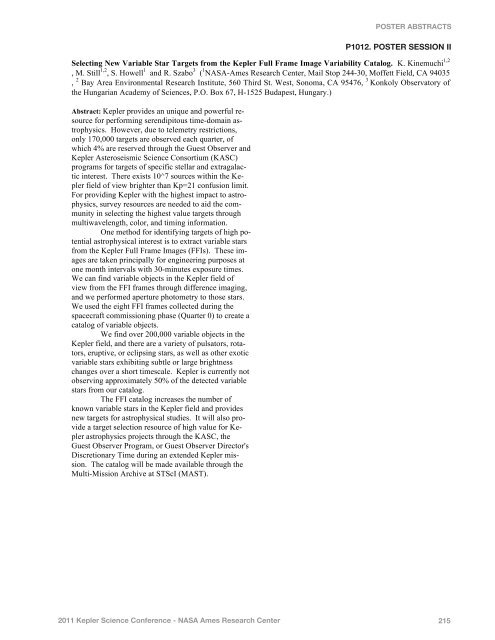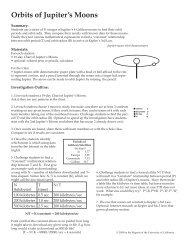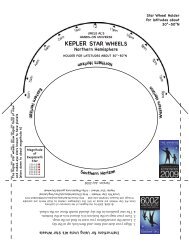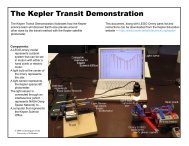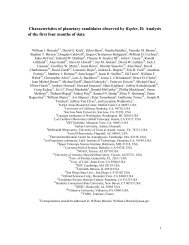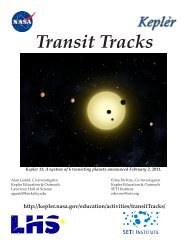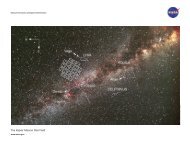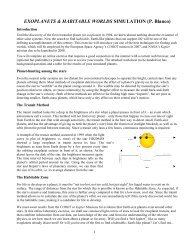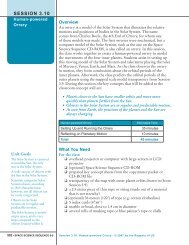Poster Abstracts - Kepler - NASA
Poster Abstracts - Kepler - NASA
Poster Abstracts - Kepler - NASA
- No tags were found...
You also want an ePaper? Increase the reach of your titles
YUMPU automatically turns print PDFs into web optimized ePapers that Google loves.
POSTER ABSTRACTSP1012. POSTER SESSION IISelecting New Variable Star Targets from the <strong>Kepler</strong> Full Frame Image Variability Catalog. K. Kinemuchi 1,2, M. Still 1,2 , S. Howell 1 and R. Szabo 3 ( 1 <strong>NASA</strong>-Ames Research Center, Mail Stop 244-30, Moffett Field, CA 94035, 2 Bay Area Environmental Research Institute, 560 Third St. West, Sonoma, CA 95476, 3 Konkoly Observatory ofthe Hungarian Academy of Sciences, P.O. Box 67, H-1525 Budapest, Hungary.)Abstract: <strong>Kepler</strong> provides an unique and powerful resourcefor performing serendipitous time-domain astrophysics.However, due to telemetry restrictions,only 170,000 targets are observed each quarter, ofwhich 4% are reserved through the Guest Observer and<strong>Kepler</strong> Asteroseismic Science Consortium (KASC)programs for targets of specific stellar and extragalacticinterest. There exists 10^7 sources within the <strong>Kepler</strong>field of view brighter than Kp=21 confusion limit.For providing <strong>Kepler</strong> with the highest impact to astrophysics,survey resources are needed to aid the communityin selecting the highest value targets throughmultiwavelength, color, and timing information.One method for identifying targets of high potentialastrophysical interest is to extract variable starsfrom the <strong>Kepler</strong> Full Frame Images (FFIs). These imagesare taken principally for engineering purposes atone month intervals with 30-minutes exposure times.We can find variable objects in the <strong>Kepler</strong> field ofview from the FFI frames through difference imaging,and we performed aperture photometry to those stars.We used the eight FFI frames collected during thespacecraft commissioning phase (Quarter 0) to create acatalog of variable objects.We find over 200,000 variable objects in the<strong>Kepler</strong> field, and there are a variety of pulsators, rotators,eruptive, or eclipsing stars, as well as other exoticvariable stars exhibiting subtle or large brightnesschanges over a short timescale. <strong>Kepler</strong> is currently notobserving approximately 50% of the detected variablestars from our catalog.The FFI catalog increases the number ofknown variable stars in the <strong>Kepler</strong> field and providesnew targets for astrophysical studies. It will also providea target selection resource of high value for <strong>Kepler</strong>astrophysics projects through the KASC, theGuest Observer Program, or Guest Observer Director'sDiscretionary Time during an extended <strong>Kepler</strong> mission.The catalog will be made available through theMulti-Mission Archive at STScI (MAST).2011 <strong>Kepler</strong> Science Conference - <strong>NASA</strong> Ames Research Center 215


